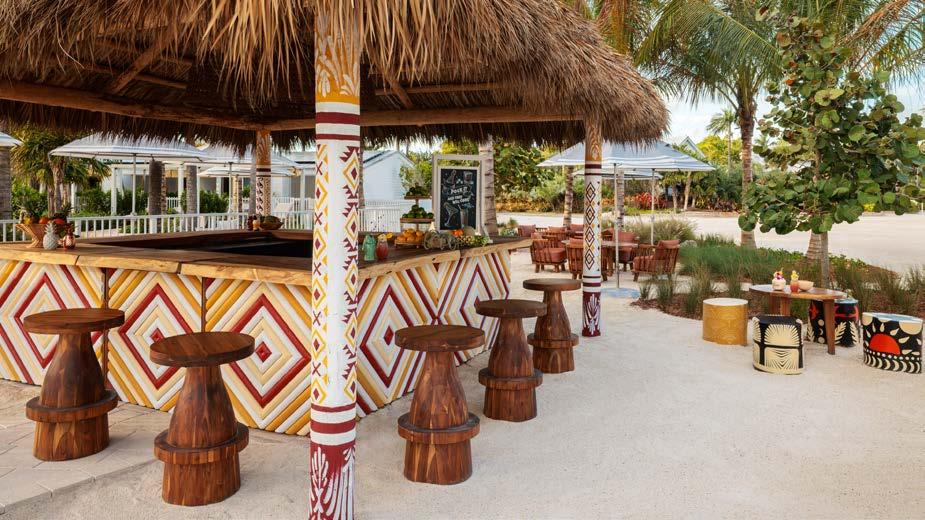

Project spotlight
Islamorada, Florida
Islamorada, a tourism-driven community in the Florida Keys, is renowned for its upscale small-town atmosphere, scenic views, boating, fishing, and vibrant local culture.
Photos: Islander Resort
Design: Gensler
Purchaser: PMI


Meet a team member
Chris Robinson VP Sales & Marketing
What do you find most fulfilling about what you do?
Designing beautifully crafted furniture that enhances a space and creates memorable experiences for guests is one of the most rewarding aspects of the work.
What are you most passionate about outside of work?
My family, my friends, and maintaining a healthy lifestyle.
What’s your favorite inspirational quote?
I have two that I frequently reference: “The happiness of your life depends upon the quality of your thoughts” and “No act of kindness, no matter how small, is ever wasted,” both by Marcus Aurelius.
Islander Resort unveils complete transformation, blending luxury with nature’s beauty
Islander Resort in Islamorada unveils a complete transformation, blending its iconic history with modern elegance. This full property reimagination includes the renovation of 114 bungalows, suites, and townhome villas, along with upgraded resort grounds, dining, and event spaces. Designed in collaboration with renowned architects and designers, the resort harmonizes contemporary luxury with the natural beauty of the Florida Keys. Each accommodation strikes a perfect balance between tropical ease and sophistication, with spacious patios and breathtaking waterfront views, inviting guests to unwind in the heart of nature.


The expansive beachfront, the largest in Islamorada, is a sanctuary for relaxation and connection. Locally crafted palapas and sun huts offer intimate retreats, while vibrant beachfront lounges create the perfect setting for leisurely days under the sun. New pools, including a family-friendly Oasis Pool and a sophisticated saltwater Terrace Pool, complement the resort’s playful spaces, like the Seaside Sports area with activities such as kayaking, paddleboarding, and bocce ball. With a commitment to the Keys’ spirit, the resort’s immersive atmosphere encourages guests to reconnect with nature, whether through sunrise yoga or adventurous excursions to the world’s third-largest barrier reef.


Creative we love



Jessica Alexander
Interior Design Director KTGY
What inspires your design work?
Travel and architecture have always inspired my design work—it really started with my Study Abroad trip to Italy in college, where I became obsessed with European architecture and craftsmanship. I’m especially drawn to the intricate details of a historic building or a curated material palette in a boutique hotel abroad. I’m definitely the one on a trip that’s frequently stopping to photograph a stone floor, the elaborate exterior of a cathedral, door hardware or an unexpected art installation. Those little details always spark inspiration and joy for me. I think travel will always be one of the main influences that reignites my passion for design.

How do you approach creating a design that is both functional and aesthetically pleasing? I always begin by thinking about how a space needs to function—how guests will move through it and the type of atmosphere I want to create. Thoughtful space planning is one of the most important early steps; it sets the groundwork for flow, usability, and the overall guest experience. Once the layout is established, I start to look at layering the aesthetic elements that always tie back to the project’s design concept. Every material, furniture piece, texture, and detail work together to shape the mood and tell a cohesive design story. The goal is always to create spaces that are purposeful, feel intentional, engaging, and tailored to the guest experience—and every design choice has an impact.
Describe a hospitality design project you are most proud of and why.
The 2022 renovation of the Waldorf Astoria Chicago remains one of my favorite projects to date. This latest renovation revived some truly remarkable spaces that had faded over time. It was also an exciting opportunity to revisit a legacy project in our firm, from its original opening in the early 2000s. We wanted to honor the timeless architectural envelope, while crafting a fresh design story that resonated with today’s guests and the property’s needs. My favorite part of the project was the transformation of the Lobby Lounge. Our goal was to reimagine the iconic space by infusing it with modern glamour and a distinct identity. It was inspired by Chicago socialite and tastemaker Bertha Honoré Palmer—known for her art and jewelry collection—we imagined the space as a modern-day parlor, as if guests were sitting in Bertha’s home today. It’s layered with lavish fabrics, curated art and luxurious furnishings. My favorite detail across the entire project is the (real) peacock feather wallcovering that we inset onto the back wall of our custom millwork niches. This really elevated the space and is one of the first details you see when arriving in the lobby but also pays tribute to the Waldorf Astoria New York’s iconic Peacock Alley. The space is now a refined setting for conversation, cocktails, and quiet luxury—one that feels collected and curated, like stepping into an artful, elevated home.
What are the most important elements of a successful hospitality design project?
There are many layers to a successful hospitality project, and no two are projects ever the same. At KTGY, we always start with in-depth research—diving into the history of the site, the surrounding neighborhood, and the local culture. This phase is where the concept narrative begins to take shape, forming the foundation for everything that follows, from space planning and finish selections to custom furniture and art programs. A strong, story-driven concept is essential; it brings clarity, cohesion, and a sense of place to the project. Equally important is aligning the design with the goals of both the brand and ownership. Every project starts by understanding how the space needs to function—how guests will move through it, what kind of atmosphere we want to create, and how we will design to support that experience. Space planning sets the framework for flow and functionality, and from there, I begin to layer in the aesthetic elements—materials, lighting, textures, and detailing that shape the mood and bring the concept to life. The goal is always to create interiors that feel seamless, engaging, and beautiful—while meeting the needs of the guest. Ultimately, it’s about designing spaces that are intuitive, guest-centered, and grounded in a strong narrative.
What are the common challenges you face in hospitality design projects, and how do you overcome them?
Tight budgets and fast-paced timelines are two of the most common challenges I see in hospitality design today. Over the years, I’ve developed a flexible, creative approach that allows me to solve problems as they arise without compromising the design story or overall quality. Whether I’m working on a luxury resort, or a lifestyle hotel, I enjoy the process of strategic problem-solving—like sourcing alternative materials that preserve the original design intent while meeting tighter budgets. I always have a stash of materials behind my desk for those last-minute reselections or value engineering exercises.


Follow along
Islander Resort

Bayside Villas, perfect for extended
or family getaways, combine home-like amenities with resort luxury, featuring two-bedroom townhomes, gourmet kitchens, and private decks with access to exclusive resort amenities.





